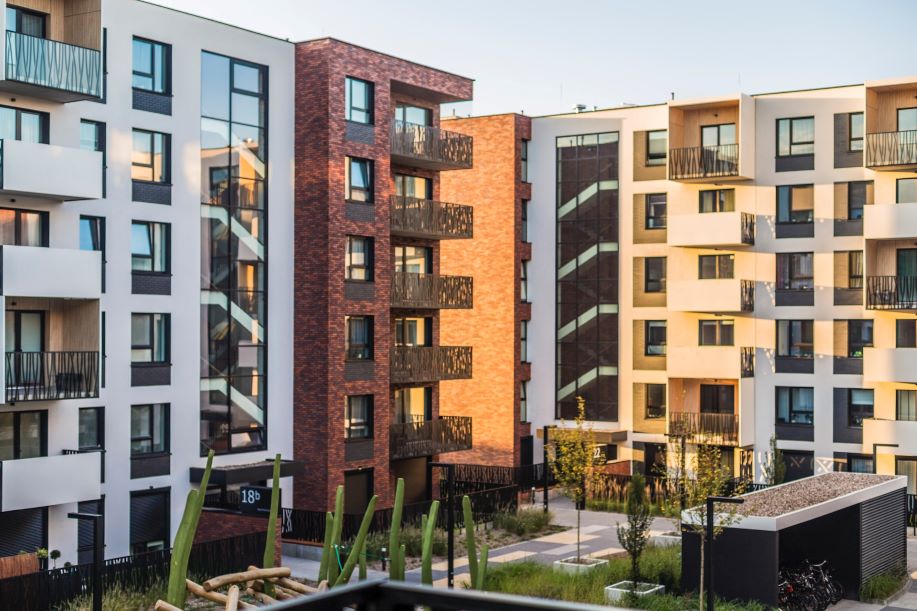Multifamily Buildings Have Unique Landscaping Needs
By Evelyn Long

People other than single-family homeowners want green lawns, trees and flowers. In the past few years, landscaping has become a more significant factor for apartment managers looking to improve their properties’ curb appeal. A well-landscaped complex shows tenants and potential renters that management cares.
However, moving into multifamily landscaping will require different features, tools and management techniques for landscapers less familiar with the niche. These five areas create challenges — and exciting opportunities — for landscapers working on multifamily housing.
Building entrance
One of the first challenges landscapers have with multifamily buildings is the entrance. Making the front of an apartment building look appealing to tenants and potential renters is essential. It’s the first thing people see when arriving at the complex, so landscapers should create a solid first impression for the client.
The entrance should be warm and inviting. One way to achieve this feeling is by planting flowers. A combination of annuals and perennials adds lovely colors to the front. People like seeing flowers because they improve their mood. Studies show that seeing flowers produces happy emotions and better social behavior.
Common area
Another unique challenge for landscapers working with multifamily buildings is creating common areas. Residents can hang out with their families, pets and neighbors in these designated spaces. Designing a place that all the tenants enjoy can be tough, but an appealing outdoor area is desirable.
Landscapers can provide an inclusive space by having an open lawn. A large area allows tenants to walk around, kick a soccer ball and have a picnic lunch. Common areas with pavement are excellent for tennis and basketball. Landscapers could also include outdoor grills and firepits. These structures promote community because tenants can sit around them and chat.
Accessible walkways
Landscapers should also consider accessibility at the entrance and common areas. A multifamily building could have one or more tenants with disabilities, so creating accessible walkways for all is critical. Property owners want to promote inclusivity and comply with the Americans with Disabilities Act (ADA) of 1990.
Landscapers can be mindful of accessibility in a few different ways. Any set of stairs should have an accompanying ramp for optimized accessibility. The ADA requires ramps to be at least 36 inches wide. Also, paths and walkways should have a design conducive to wheelchairs. Any garden shouldn’t get in the way of wheelchair paths.
Green spaces
The past few years caused a shift in what tenants want in their apartments. Sustainability has become a much higher priority. Consumers desire green spaces, even in their apartment buildings. They want the opportunity to create gardens and mini greeneries despite not having a yard.
Consumers still want the shared outdoor space. Landscapers could create a rooftop garden on multifamily buildings. These gardens, also known as green roofs, are ideal for apartments because they provide positive aesthetics with plants and trees. They also mitigate heat islands on the roof and reduce energy use for the building. The surface temperatures of green roofs can be up to 40 degrees lower than ordinary roofs.
Lighting
Residents want to feel safe walking around the complex and entering their apartments. Tenants may fear taking out the trash or walking their dogs at night. One way landscapers can help is by providing adequate lighting around the complex. Coming home after a long day and seeing brightly lit walkways and doorways is a welcome sight.
Landscapers should look at a few factors when choosing light fixtures, including:
- Cool over warm: The shade is among the light’s most important aspects. Landscapers should choose cooler, lighter tones because they’re more pleasing to the eyes. A warmer tone may produce a yellow tint that is less appealing, and residents will feel safer with a lighter tone.
- Light height: Another factor to consider is the height of the light. Fixtures close to the ground may produce a light that’s too bright and harsh on the eyes. Lights too high up will not effectively spread illumination. The lumen output will give landscapers a better idea of how high to put the lights.
- Durability: Lighting is a critical aspect many residents value, so landscapers should opt for durable parts. These outdoor fixtures must handle conditions like snow, rain, wind and more. Silicone is a terrific gasket option. Brass fixtures for walkways will last for years.
Landscaping can tell a lot about a property by showing how much the owners care about maintenance and appearance. It matters for multifamily residences as much as it does for single-family homes. However, it does present unique challenges. Landscapers can use this guide to navigate work for apartment complexes and other multifamily buildings.
Evelyn Long is a writer and editor focused on home building and construction. She is the co-founder of Renovated, a web magazine for the home industry.


